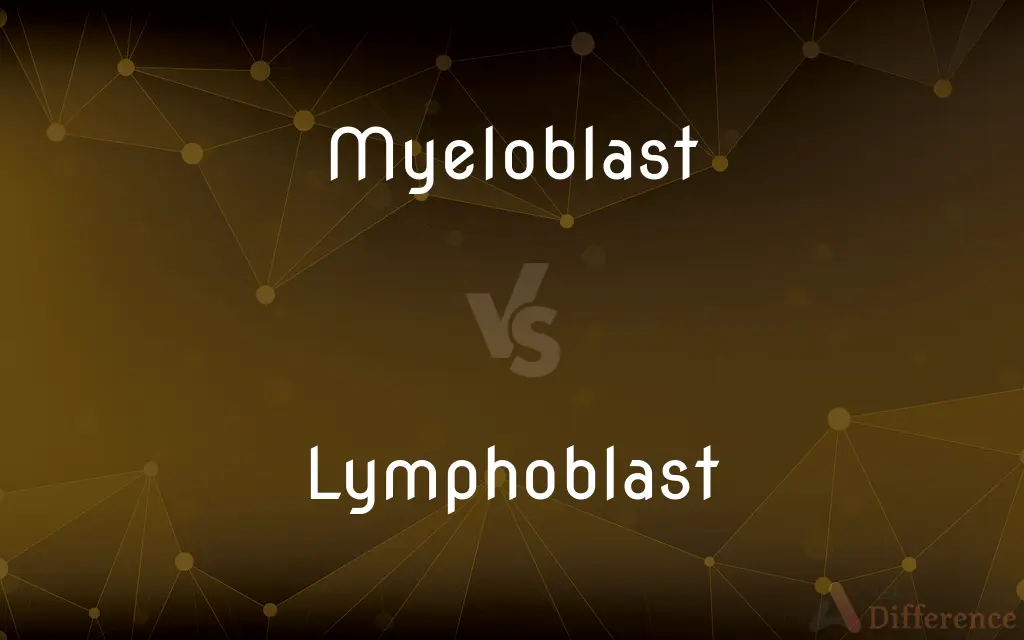Myeloblast vs. Lymphoblast — What's the Difference?
By Maham Liaqat & Fiza Rafique — Updated on April 15, 2024
Myeloblasts are precursors to myeloid lineage cells, crucial in forming elements like neutrophils and monocytes, while lymphoblasts develop into lymphocytes, key to the immune response.

Difference Between Myeloblast and Lymphoblast
Table of Contents
ADVERTISEMENT
Key Differences
Myeloblasts are immature cells in the bone marrow that differentiate into various types of myeloid cells such as neutrophils, eosinophils, basophils, and monocytes, which are essential for innate immunity and inflammatory responses. On the other hand, lymphoblasts are progenitors that give rise to lymphocytes, including B cells, T cells, and natural killer cells, which are central to adaptive immunity and specific immune reactions.
Myeloblasts are identified in laboratory settings by their fine, lacy chromatin and distinct nucleoli within a large nucleus, and a small amount of cytoplasm. Whereas, lymphoblasts are recognized by their smaller size, more condensed chromatin, and relatively more cytoplasm compared to myeloblasts, aiding in the diagnosis of different types of leukemia.
In conditions like acute myeloid leukemia (AML), myeloblasts proliferate abnormally, disrupting normal blood cell production and function. Conversely, lymphoblasts are involved in conditions such as acute lymphoblastic leukemia (ALL), where their unchecked growth leads to similar disruptions in normal lymphocyte formation and immune function.
Treatment for disorders involving myeloblasts often includes chemotherapy, targeted therapy, and sometimes bone marrow transplants, focusing on reducing myeloblast counts and restoring normal hematopoiesis. In contrast, treatments for lymphoblastic disorders might also include these methods but are tailored to the specific type of lymphocytes involved and the genetic markers of the lymphoblasts.
Understanding the biological behavior and developmental pathways of myeloblasts helps in managing diseases like AML and chronic myeloid leukemia. However, understanding lymphoblasts is crucial for developing targeted therapies and immunotherapies in diseases like ALL and lymphoblastic lymphoma.
ADVERTISEMENT
Comparison Chart
Lineage
Myeloid
Lymphoid
Subtypes They Differentiate Into
Neutrophils, eosinophils, basophils, monocytes
B cells, T cells, natural killer cells
Chromatin Appearance
Fine, lacy
Condensed
Cytoplasm Amount
Less
More
Associated Disorders
Acute Myeloid Leukemia (AML), Chronic Myeloid Leukemia (CML)
Acute Lymphoblastic Leukemia (ALL), Lymphoblastic Lymphoma
Compare with Definitions
Myeloblast
An immature cell that develops into myeloid lineage cells involved in innate immunity.
The increase in myeloblasts can indicate an onset of acute myeloid leukemia.
Lymphoblast
Known for its more condensed chromatin and increased cytoplasm.
The biopsy showed lymphoblasts with characteristic chromatin.
Myeloblast
Contributes to the production of essential immune cells like neutrophils.
The myeloblast’s role is crucial in the body's defense mechanism against bacterial infections.
Lymphoblast
Essential in producing lymphocytes that combat viruses and tumors.
Lymphoblast activity is vital for a responsive immune system.
Myeloblast
Often involves chemotherapy and bone marrow transplants.
The patient underwent chemotherapy to reduce myeloblast count.
Lymphoblast
Involved in acute lymphoblastic leukemia.
His diagnosis was ALL, caused by abnormal lymphoblasts.
Myeloblast
Recognized by its large nucleus and fine chromatin.
During the lab test, the myeloblast was identified by its distinct nucleoli.
Lymphoblast
Includes immunotherapies and chemotherapy.
She received targeted therapy to control lymphoblast growth.
Myeloblast
Central in diseases like AML where they proliferate uncontrollably.
Treatment for AML targets the abnormal proliferation of myeloblasts.
Lymphoblast
A progenitor cell leading to the formation of adaptive immune cells.
In the patient, lymphoblasts were differentiated into T cells.
Myeloblast
The myeloblast is a unipotent stem cell which differentiates into the effectors of the granulocyte series. It is found in the bone marrow.
Lymphoblast
A lymphoblast is a modified naive lymphocyte with altered cell morphology. It occurs when the lymphocyte is activated by an antigen (from antigen-presenting cells) and increased in volume by nucleus and cytoplasm growth as well as new mRNA and protein synthesis.
Myeloblast
An immature cell of the bone marrow that is the precursor of a myelocyte.
Lymphoblast
A large, immature lymphocyte that has been activated by an antigen and divides to give rise to mature lymphocytes (B cells and T cells).
Myeloblast
(biology) An immature cell of bone marrow that develops into a myelocyte.
Lymphoblast
An immature lymphocyte; they proliferate uncontrollably in lymphoblastic leukemia
Myeloblast
A precursor of leukocytes that normally occurs only in bone marrow
Lymphoblast
An immature lymphocyte
Common Curiosities
What is a myeloblast?
A myeloblast is an immature bone marrow cell that differentiates into various types of myeloid cells.
How are myeloblasts and lymphoblasts identified?
Myeloblasts have fine, lacy chromatin, whereas lymphoblasts feature more condensed chromatin.
What is a lymphoblast?
A lymphoblast is an immature cell that gives rise to lymphocytes involved in the adaptive immune system.
What is the role of lymphoblasts in the immune system?
Lymphoblasts mature into lymphocytes, key players in adaptive immunity.
What disorders are associated with myeloblasts?
Disorders like acute myeloid leukemia and chronic myeloid leukemia involve myeloblasts.
What is the role of myeloblasts in the immune system?
Myeloblasts develop into cells like neutrophils and monocytes, crucial for innate immunity.
Can myeloblasts and lymphoblasts be differentiated by their physical appearance?
Yes, myeloblasts generally have less cytoplasm and a larger nucleus compared to lymphoblasts.
What is the prognosis for diseases involving myeloblasts?
The prognosis can vary widely based on the specific type and progression of the disease.
What disorders are associated with lymphoblasts?
Lymphoblasts are central to conditions such as acute lymphoblastic leukemia.
What are common symptoms of disorders involving lymphoblasts?
Symptoms often mirror those involving myeloblasts but may also include enlarged lymph nodes.
How are diseases involving lymphoblasts treated?
Treatments may involve chemotherapy, targeted therapies, and immunotherapies.
How do myeloblasts and lymphoblasts contribute to leukemia?
Both cell types can proliferate abnormally, leading to different forms of leukemia.
What are common symptoms of disorders involving myeloblasts?
Symptoms include fatigue, frequent infections, and abnormal bleeding.
How are diseases involving myeloblasts treated?
Treatments include chemotherapy, targeted therapy, and bone marrow transplants.
What is the prognosis for diseases involving lymphoblasts?
Prognosis depends on factors like age, specific subtype of leukemia, and response to treatment.
Share Your Discovery

Previous Comparison
Kwashiorkor vs. Marasmus
Next Comparison
Technology vs. ScienceAuthor Spotlight
Written by
Maham LiaqatCo-written by
Fiza RafiqueFiza Rafique is a skilled content writer at AskDifference.com, where she meticulously refines and enhances written pieces. Drawing from her vast editorial expertise, Fiza ensures clarity, accuracy, and precision in every article. Passionate about language, she continually seeks to elevate the quality of content for readers worldwide.















































